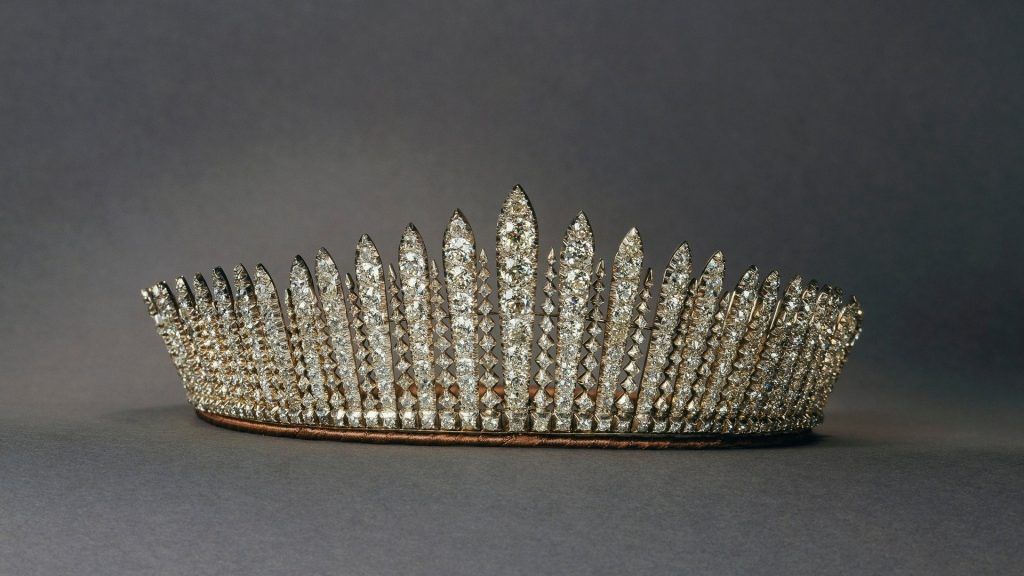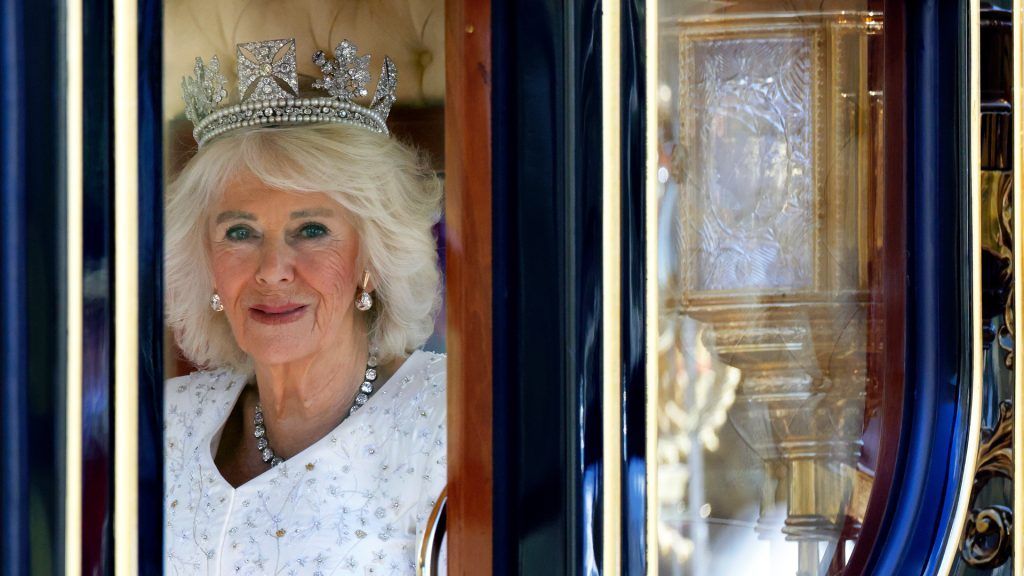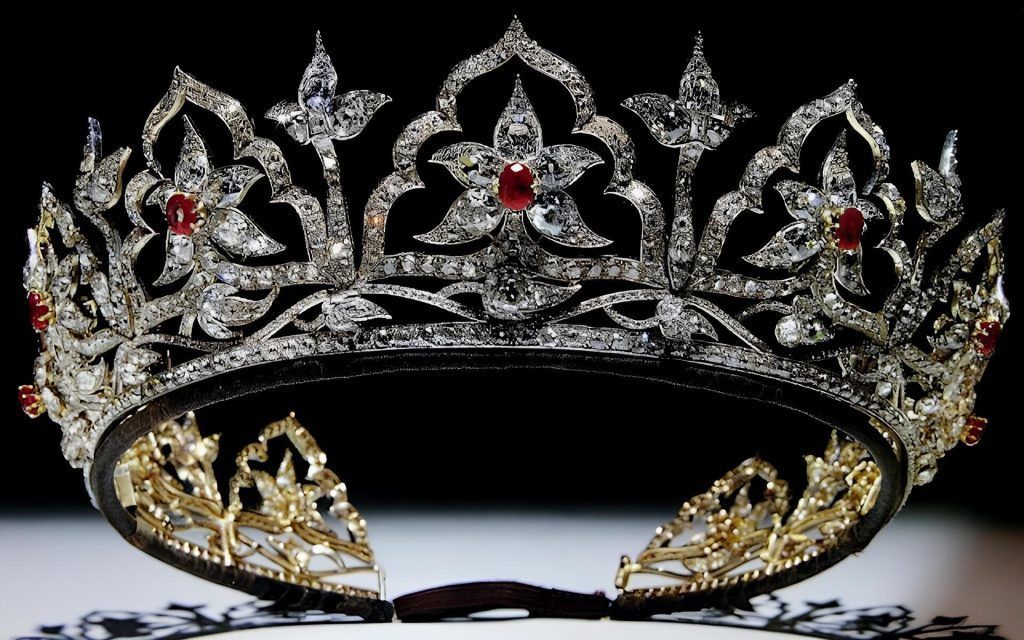In the height of the Russian revolution, the tiara was dramatically smuggled of the country, and was eventually sold to Queen Mary of Teck in 1921. Throughout the years, the tiara has undergone several renovations and reconstructions, and today is made of platinum. In 1924, Queen Mary would arrange for 15 of the Cambridge cabochon emeralds to be mounted as pendants, so that they could be worn in place of the pearls. The versatile tiara could also be worn without the pendants, allowing its elegant silhouette to shine. Indeed, as a personal favourite of Queen Elizabeth II, the Vladimir tiara has more than seen its share of the sun, with the sprightly queen even commenting that it is ‘quieter’ when worn without the hanging stones.
Perhaps one of the most widely-seen British royal tiaras of today, the Queen Mary’s Lover’s Knot tiara was a particular favourite of Princess Diana’s, and today, is worn by her daughter-in-law, Catherine, Princess of Wales. A beautiful piece well deserving of its place in contemporary royal history, the diadem first came to life in 1913, when it was commissioned by Queen Mary.
Produced by E. Wolff & Co. for the House of Garrard using diamonds and pearls from Queen Mary’s private collection, the tiara was made to mirror the Cambridge Lover’s Knot tiara, which was owned by Queen Mary’s grandmother, Princess Augusta of Hesse-Kassel. It is said that Queen Mary sacrificed one of her own pieces — the Ladies of England tiara — to produce the replica.
Its design is inherently gothic revival, prominently featuring lover’s knot bows repeated along the entire length of the tiara. 19 oriental pearls sit perfectly suspended beneath each knot, each featuring a large brilliant-cut diamond. Upon her death, Queen Mary passed the tiara on to Queen Elizabeth II; the tiara would eventually find its way to Princess Diana, for whom it became a great favourite despite its staggering weight. On Diana’s divorce from King Charles III (then Prince Charles), the tiara was returned to the palace and safely stored away. It remained out of public sight until 2015, when Catherine, Princess of Wales, publicly wore it for the first time at that year’s annual diplomatic reception. It remains a personal favourite of the Princess, who has worn it faithfully through the years for numerous state occasions. This British royal tiara is estimated to be worth £1 million.
A wedding gift presented to Queen Elizabeth II (then Princess Elizabeth) from her mother-in-law, Princess Alice of Greece and Denmark (also known as Princess Andrew), the Meander tiara, which is also known as Princess Andrew’s meander tiara, features neoclassical Greek and Roman design elements.
The classically sleek tiara borrows its series of interlocking spirals from the design of the Greek key; a traditional symbol of harmony, it is a favoured design for royal bridal tiaras. The spirals are punctuated by large diamonds, each wreathed in laurels and scrolls to lend additional sparkle and shine.
Although Queen Elizabeth herself never wore the tiara publicly, it was nonetheless occasionally worn by her sister, Princess Margaret. In 1972, this British royal tiara was given to Princess Anne, who for all intents and purposes appears to favour it greatly. The tiara in question was worn during her engagement to Captain Mark Phillips in 1973, and for an official portrait to mark her 50th birthday. In 2011, the tiara was loaned to her daughter, Zara Phillips, who wore it for her wedding.
Queen Mary’s Fringe tiara

First commissioned in 1919, the fringe tiara is a beautiful kokoshnik-style piece that was forged using diamonds that were part of Queen Victoria’s wedding gifts to Queen Mary (then Princess Mary) in 1893. Named for the spires that form its iconic shape, this British royal tiara began its life as a necklace that had once been worn by Queen Victoria and Queen Alexandra, until it was transformed into its current state. As a tiara, it was well-loved by Queen Mary, who favoured it over Queen Alexandra’s kokoshnik which had been larger, and likely harder to manage.
The tiara would eventually be given to Queen Elizabeth (The Queen Mother) in August of 1936. Since then, it has become a well-loved wedding tiara, and has been worn at three royal weddings: that of Queen Elizabeth II (Then Princess Elizabeth) in 1947, Princess Anne for her wedding to Captain Mark Phillips in 1973, and Princess Beatrice for her wedding to Edoardo Mapelli Mozzi in 2020.
A magnificent masterpiece of splendour, Queen Mary’s Fringe tiara boasts 47 tapering bars bearing 633 brilliant and 271 rose diamonds; these are arranged in alternating fashion with smaller spikes bearing lozenge-set diamonds. Because of its versatile nature, the tiara can also be worn as a necklace — though there is quite literally, a catch. As Queen Elizabeth II (then Princess Elizabeth) was getting dressed on the day of her wedding, the tiara snapped by accident.
The monarch later recounted of the incident, “The catch, which I didn’t know existed, it suddenly went [gesturing with her hands]”. Thankfully, the court jewellers Garrard had been stationed on site in case of emergency, and the tiara was restored in time for the proceedings. Oh, happy day.
The tiara is estimated to be worth £5 million.
Greville Emerald Kokoshnik tiara

Perhaps the grandest and most expensive piece in the British royal family’s collection of jewels, the Greville Emerald Kokoshnik tiara is estimated to be worth a staggering £10 million. Once a part of an incredible chest of jewels belonging to British society hostess and philanthropist Dame Margaret Greville (also known as Mrs. Ronnie Greville to the London social set), the tiara, alongside many other glittering bon bons, came to land in the hands of Queen Elizabeth, the Queen Mother, through an unlikely friendship and an uncanny bequest.
A close friend of King Edward VII, Dame Margaret maintained fond ties with King George V and Queen Mary of Teck. This multi-generational friendship would endure the years, and she fostered a familial relationship with King George VI and Queen Elizabeth, The Queen Mother, frequently referring to the latter as the ‘daughter she had never had’. Upon her death, her extraordinary collection of jewellery, which included over sixty pieces from jewel houses the likes of Cartier and Boucheron, was bequeathed to The Queen Mother. Among them: The Greville Emerald Kokoshnik tiara.
@emoprincesseugenie also fun fact!! It’s the queens most expensive tiara at $18m.(£10m.)!!🍀💚👒#royalfamily#fashionhistory#princesseugenie#princessdiana#meghanmarkle
While rumoured to be The Queen Mother’s favourite, the sparkling tiara never saw the light of day — at least not until the wedding day of Princess Eugenie of York in 2018, when it was worn as part of the princess’ wedding ensemble. The 1920s Art Deco piece, which was constructed by French jewellery house Boucheron, features brilliant and rose cut diamonds pavé set in platinum, and thirteen emeralds – the largest of which is a cabochon rumoured to weigh 93 carats.
The George IV State Diadem

While not necessarily a British royal tiara, the George IV State Diadem presents far too imposing and extraordinary a profile to be excluded. Crafted by Rundells in 1820 for the notoriously colourful coronation of King George IV, the opulent diadem features a silver and gold-lined openwork frame set with 1,333 diamonds (weighing 320 carats) and a narrow band of pearls.
Four crosses-pattée encircle the diadem alongside four sprays to represent the national emblems of England, Ireland, and Scotland: roses, shamrocks, and thistles. A four-carat pale yellow brilliant diamond sits in pride of place within the front cross.
With precious stones regularly hired for use in coronations at the time, there is little evidence that those upon the diadem have been disturbed or removed. Rightfully, this fuels the deduction that they had been bartered for with old stones of equal worth from the king’s extensive personal collection. To date, this symbolic diadem has graced the heads of four queens: Queen Victoria, Queen Alexandra, Queen Mary, and Queen Elizabeth II, who wore it for her coronation, and every year of her reign thereafter at the State Opening of Parliament. It is meant only for sovereigns and queen consorts.
The Oriental circlet

If for no other reason besides how pretty it is, the Oriental Circlet is well deserving of its place on our list of British royal tiaras. Commissioned and designed by Prince Albert in 1853 for his beloved wife Queen Victoria, the stunning circlet is composed of seventeen ‘Moghul arches and lotus flowers’ and was made by court jewellers Garrard & Co. Originally set with some 2,600 diamonds and opals, which were the prince’s favourite stones, the circlet was well-received by the young queen, who then commissioned a matching opal necklace, opal earrings, and an opal brooch.
The circlet would come to be remodelled in 1858 following a successful Hanover claim to some of its royal jewels, which were then removed and returned. Queen Victoria would then replace them by breaking some of her old jewels and buying new diamonds. Following the death of her husband Prince Albert in 1861 and well into her widowhood, Queen Victoria never wore the circlet again. It was subsequently designated as an Heirloom of the Crown upon her own death in 1901. In 1902, the circlet was remodelled by her daughter-in-law, Queen Alexandra, who reduced the arches to eleven, and replaced the opals with rubies. Parts of the tiara were also made to be removable, so as to accommodate a time when ‘a lighter and more simple tiara is required’.
@matta_of_fact One of the priciest #tiaras owned by the #royalfamily 👑 #QueenElizabeth #QueenVictoria #MeghanMarkle #PrincessDiana
The tiara was eventually passed on to Queen Elizabeth, The Queen Mother, for whom it appeared to be a great favourite — so much so that she retained it for personal use despite her daughter, Queen Elizabeth II’s, queenly ascension. Since her passing in 2002, it has only been worn once: by Queen Elizabeth II during a State Visit to Malta in 2005. The Oriental circlet is estimated to be worth £6 million today.
(Main and featured images: Chris Jackson/Getty Images)
Frequently Asked Questions (FAQs)
– How many tiaras does the British royal family have?
While it is difficult to note an exact number, it is estimated that the British royal family’s collection includes at least 50 tiaras.
– What is the history of royal tiaras?
It is widely accepted that tiaras originated from Ancient Greece, where simple laurel headbands were used to crown Olympic winners and victorious warriors.
Generally perceived to be royal headpieces, tiaras derive their origin from simple laurel headbands that were used to crown Olympic winners and warriors returning from victory in Ancient Greece.
– Why do royals wear tiaras?
Tiaras are symbolic of power and authority, both emblematic of sovereign rulers since ancient times. Royals today wear tiaras as a way to maintain age-old traditions maintained by the aristocracy.
– What is the oldest royal tiara in the UK?
The Palatine Crown, also known as the Crown of Princess Blanche dates as far back as 1370-1380. It is the oldest surviving royal crown that is recorded to have been in England, though it is currently on display in the treasury of the Munich Residenz. Other historical crowns and tiaras include St. Edward’s Crown (1661), the Grand Duchess Vladimir tiara (1874), Queen Alexandra’s Kokoshnik tiara (1888), and The Girls of Great Britain and Ireland tiara (1893).
Read More: World News | Entertainment News | Celeb News
247
